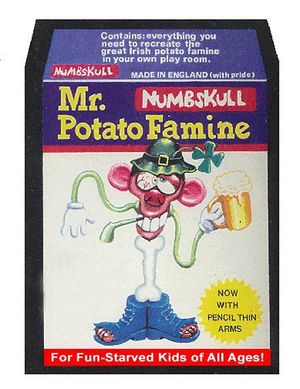Irish Potato Famine
Nutrition labels are statements of nutritional value and ingredients on food items. But that's not what I want to write about. I want to write about the Irish Potato Famine, a period of mass starvation, disease and emigration that occurred in Ireland between 1845 and 1852. A disease affecting potatoes known as "potato blight"[1] was ultimately to blame, but most chose, and some still do to this day, to believe the famine was part of a greater conspiracy to further worsen living conditions in Ireland by the United States in order to force Irish workers to come build the transcontinental railroad.
The famine killed more than a million people and nearly imploded the Irish economy[2] due to Irish currency's being backed by potatoes. Some historians disagree with me on this point by falsely claiming that Ireland was governed by the United Kingdom at the time and that Ireland had no regional currency (apart from beer and clover obviously). I contest this on the basis that I am right and they are plainly wrong.
Beginning[edit | edit source]
So there Ireland was, just an island in Northwestern Europe, a stone's throw away from Japan. It was looking idly at the ongoings of Europe, which was already dealing with the potato blight but couldn't care much about it. France was too busy raping Hajis in Algeria so that Albert Camus could pen The Stranger a century later, and Spain was too busy repeatedly declaring war on itself. Irish officials felt that their island was safe from the blight because they had just filled the Irish Sea with alligators to ward off the periodontitis-laden imperialists from the other island. Despite these efforts, several potatoes which had already got some sick made their way to the isle. Conspiracy theorists claim that the alligator infested Irish Sea would've made a point of entry from the east impossible, and thus the sickly index case potatoes must have come from America.
Regardless of where it came from, we do know that someone set up Ireland the blight because shit started going downhill real fast. It took only a handful of pocket crops to fail for people to take notice and start making a fuss. Irish authorities, fearing that an agricultural pandemic was looming, immediately acted in their normal fashion by doing nothing.
Middle[edit | edit source]
The potato sickness soon spread, infecting and destroying crops in all parts of Ireland. The poor were affected first and most severely since a majority of their diet were potatoes of some dish variety. At first, the Irish upper-class welcomed the potato famine as it initially killed off only the "vermin" of society. Soon, however, it began to kill off their labor force and even their own kind. The aristocracy, the middle-class, and every other intelligent person left Ireland around this time, leaving only drunks, perverts and Catholics to fend the British off.
Many of them emigrated to the United States with bigger dreams than they could've hoped for at home.[3] Unfortunately, Irish Americans, like many migrants at the time, were often rounded up at docks and drafted in to the American Civil War. Another large percentage of them went to work in the railroad industry where they found great positions as burrow replacements.
Back in Ireland, the crisis raged on. Ireland's loss of its primary crop affected all aspects of Irish society: farmers were unable to pay rent and were evicted, land was abandoned, hungry workers went on strike, the value of Ireland's currency fluctuated due to the increasing rarity of the potatoes (which backed the Irish currency at the time), and poverty became cliché. Rational families sold their children into slavery for a head of cabbage each.
End[edit | edit source]
The Irish government, looking for a effective quick solution to the societal ills which accompanied riding out the blight pandemic, looked to Johnathan Swift's 1729 essay A Modest Proposal For Preventing the Children of Poor People in Ireland from Being a Burden to Their Parents or Country, and for Making Them Beneficial to the Public which suggested the Irish systematically eat their own children. Finding this reasonable, they swiftly announced to the public that all families who ate one of their children would be rewarded with a stipend for a fortnight to stimulate economic growth and stave off hunger. The government also backed the currency on whiskey with the assurance that Ireland's whiskey would never cease production.[4]
Exactly how many children were actually eaten by the starving Irish is indeterminable, but we do know that the Irish population of those aged 3–12 dropped by 67% in the years immediately following the government's plan. Of course, there were protests concerning the government's handling of the famine. All attempted rebellions and riots were quickly squashed, leaving dissenters and political troublemakers hungry and dead.
Aftermath[edit | edit source]
A sentiment still exists in Ireland that children are the bane of society, for they produce nothing of worth. This is reflected through steady rises in incidents which most would see as child abuse or neglect within Ireland. Some sociologists have likened Irish parents to being much like offspring-devouring wolf spiders who will not hesitate to devour their own children on the smallest whim.
Memorials for the potato famine have since been established. A large stone wall with the names of people known to have died in the famine was designed in 1932 and is currently on display at the Dublin Museum of Irish Misery, the largest museum in the world. Some have complained about the exhausting list of people with surnames starting with the letter "O" which makes it exceptionally difficult to locate ancestors. According to the wall, nearly eight thousand people with the name "Séamus O'Sullivan" died during the potato famine in 1847.





